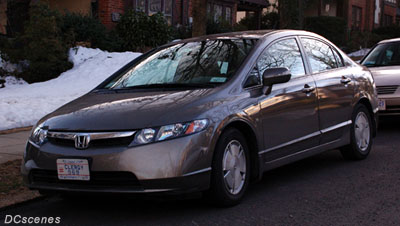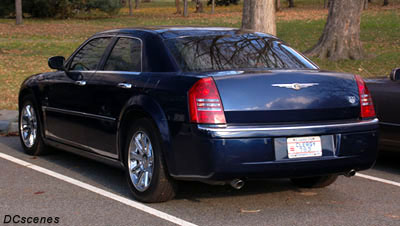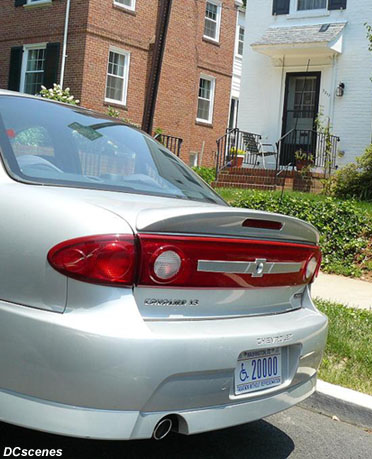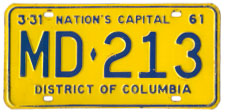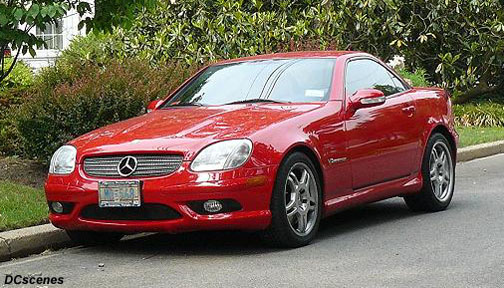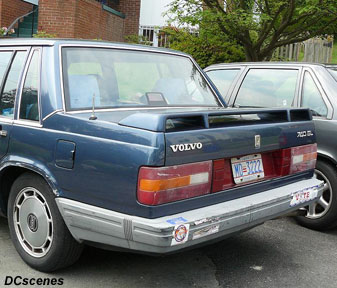Non-Passenger License Plates
Page I: Introduction to Non-Passenger Plates; Privately-Owned Vehicle Types
Click here to see a list of D.C. plate types with links to their descriptions. |
Click here to reach our page dedicated to non-passenger plates issued from 1965 through 1974. |
Introduction to Non-Passenger Plates
In general, non-passenger plates are registration plates (as opposed to sample plates and permits) other than those issued for use on private passenger vehicles. Defining and categorizing non-passenger plates can be difficult. For example, most DMVs consider personalized (i.e. "vanity") plates regular auto plates whereas plate collectors usually consider them representative of a separate type.
The early history of Washington, D.C. non-passenger plates is spotty at best. The earliest ones appear to be distinctive motorcycle and dealer plates known to have been introduced in 1908 and 1919, respectively. It is unclear how many other types, if any, were made and issued during the early and mid-1920s, but we do know that with the introduction of letter prefixes to most D.C. plates in 1927, an organized system of type identification came into use.
Non-Passenger Plate Numbering. Although more research is needed, it appears that the system of identifying non-passenger plates by letter prefixes was used through 1934. All-number plates returned for 1935, and from this year through the late 1940s the type name was generally embossed on the plate, although in some instances (such as commercial) letter prefixes continued to be used.
Letter prefixes returned in the late 1940s and type names were then omitted, making it confusing for today's collector who seeks only passenger car plates. Especially during the 1950s through the 1960s, as was the case from 1927 through 1934, the only way to differentiate between plates of various types (including passenger) is to know which letter prefixes were used on the various types. Since the mid-1960s the non-passenger status has been evident, at least to the trained eye, in the numbering format or other attributes (such as an embossed year designation for a year in which auto plates were validated with a sticker).
More information about the numbering of Washington, D.C. license plates, passenger and non-passenger, may be found on our Reserved-Number Plates page as well as throughout our year-by-year history. In addition to numbering information specific to each annual plate or multi-year baseplate that may be reached using links located on the year-by-year history introductory page, numbering characteristics of certain eras and types are addressed separately within the year-by-year history and on pages devoted to various types, respectively, and may be reached using these links:
Characteristics, including numbering, of non-passenger plates of the late 1960s and early 1970s are particularly confusing, mostly because these plates are not entirely understood. Click here to reach our page about plates of this period.
Military Service-Related Plates
Special license plates made available to military veterans are not considered non-passenger plates. Their classification and location on this Web site are as follows:
| D.C. Veteran | Optional Plates |
Purple Heart Recipient |
|
Disabled American Veteran - regular |
|
Disabled American Veteran - handicapped |
|
Veterans of Foreign Wars |
Washington, D.C. Types
Washington, D.C. registration types and other common license plate classifications are addressed on separate pages (including this one) in five categories. Each type with its name shown in CAPITAL letters is described on a dedicated page.
II. Public Service |
||||
ELECTED OFFICIAL (various) |
||||
Privately-Owned Vehicle Types
Types addressed on dedicated pages are listed at the bottom of this page.
| Clergy | First Issued: 1975 |
Current Type Designation: CLERGY |
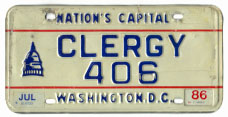
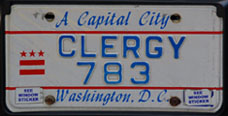
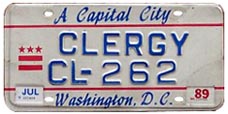
Most U.S. states have at least one type that isn't issued in any other state, and D.C. is no different. Clergy is the type that first comes to the mind of most plate aficionados when asked to identity D.C.'s unique type.
Distinctive plates for members of the clergy were first issued on the Bicentennial base in 1975, and although no examples of a vintage more recent than the 1984 (A Capital City) base have been observed, as of mid-2010 these plates continue to be used and revalidated. The plate layout has always been similar (and unusual for D.C.), with the type name in relatively large letters and the number printed in unusually small figures. From the DMV's perspective, registration numbers of this type are prefixed by the letters "CL," although we believe this type designation code should not appear on the plates themselves. If this is the case, then no. 262 with the code (pictured) was probably made in error when a replacement for a lost plate was requested. We have seen no other Clergy plates that include the type code.
| Diplomatic - WN Series | First Issued: 1965 |
Issuance Discontinued: c.1985 |
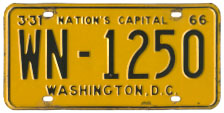 |
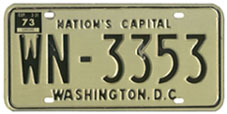 |
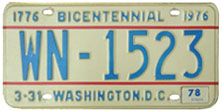 |
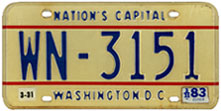 |
This second series of diplomatic plates was introduced at the beginning of the 1965 (exp. 3-31-66) registration year to identify vehicles owned by embassy personnel that were not of sufficient status to obtain DPL-prefix plates (which are addressed separately here). The justification statement presented by Director of Motor Vehicles George A. England in a February 1965 memorandum to the Commissioners in which he recommended that the series be created is as follows:
“This amendment to the annual tag order [for 1965 plates] is requested in order to provide a greater number of tags for assignment to registered owners with diplomatic status. Diplomatic (DPL) tags by statute are available only to accredited representatives of a foreign government and are issued annually without charge. There are many other foreign representatives here who enjoy diplomatic status but who cannot qualify as accredited representatives. Those of this group who have automobiles registered in the District of Columbia purchase tags which are assigned in the regular series. As a result of our program dealing with scofflaws, these people are often embarrassed by receiving warrants requiring appearance in court when as a matter of fact, the District has no authority to require such appearance. In order to deal with this problem, the State Department has asked that a special series of tags be set aside so that the Central Violations Bureau will have the means of identifying these persons with diplomatic status and thus not issue warrants. This program will have benefits not only to the State Department and the diplomats, but also to the District officials who administer the program to which I have referred above.”
The significance of the WN prefix is unknown. On the first-issue 1965 base, numbers were assigned beginning at WN-1001. Like regular diplomatic plates, this type was replaced by plates introduced by the U.S. Department of State in 1985.
| Foreign Organization | First Issued: unknown |
|
Foreign Organization plates were introduced in D.C. (and many states in which Taiwan has official representation) presumably because this island, part of the Republic of China, does not have a separate seat in the United Nations, a distinction that would permit its representatives to obtain official diplomatic plates issued by the U.S. Dept. of State.
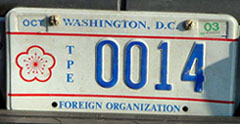 Taiwan lost its separate seat in the U.N. in October 1971 upon the admittance of the People's Republic of China. Since then, the Taipei government has continually lobbied for a separate seat, as well as, of course, independence from China. Taiwan's autonomy in the U.N. has repeatedly been denied by Beijing. An increase in visible signs of Taipei's push for independence, even if in the form of something as simple as license plates used on the other side of the globe, may have come as a result of the election of pro-independence candidate Chen Shui-bian to the presidency in March 2000. D.C.'s Foreign Organization plates are thought to have been introduced in the same year as the historic election that brought about the end of 50 years of Nationalist rule.
Taiwan lost its separate seat in the U.N. in October 1971 upon the admittance of the People's Republic of China. Since then, the Taipei government has continually lobbied for a separate seat, as well as, of course, independence from China. Taiwan's autonomy in the U.N. has repeatedly been denied by Beijing. An increase in visible signs of Taipei's push for independence, even if in the form of something as simple as license plates used on the other side of the globe, may have come as a result of the election of pro-independence candidate Chen Shui-bian to the presidency in March 2000. D.C.'s Foreign Organization plates are thought to have been introduced in the same year as the historic election that brought about the end of 50 years of Nationalist rule.
| Handicapped Person | First Issued: c.1981 |
|
Washington, D.C. followed the lead of many states in the late 1970s and early 1980s by introducing specially-marked license plates for motorists with disabilities. The type debuted on the 1978 (Nation's Capital) base, and although the introduction date is unknown we assume it was between April 1978 through September 1984, when this base was being issued for new passenger registrations. Plate no. H/P 156 (pictured below) appears to have first been issued with an exp. 3-31-82 sticker, meaning that it was likely issued during 1981. Therefore, it appears that the type was introduced in 1980 or 1981.
Based upon the existence of plate no. H/P 055, we assume that numbering began at H/P 000 or H/P 001. Like plates of other types, registration numbers have been assigned sequentially from baseplate to baseplate. By the end of 2011 numbers had reached approximately 21200, meaning that 21,200 sets of plates were likely issued during the first 30 years of this type. Assuming there has never been a general reissuance of this type, an average of just over 700 HP registrations appear to have been issued annually from 1981 through 2011.
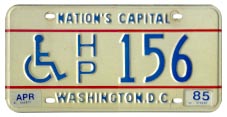 |
1978 Baseplate The lowest and highest numbers observed on the first-issue base of this type are H/P 055 and H/P 2461. | |
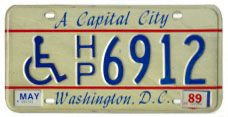 |
1984 Baseplate This base likely debuted in Oct. 1984, when the design was introduced for auto plates, or possibly shortly thereafter. On 4-digit plates (through H/P 9999) the wheelchair motif is embossed, whereas it is silk-screen printed on the only 5-digit plate seen. The lowest and highest observed plates are H/P 3450 and H/P 10111. |
|
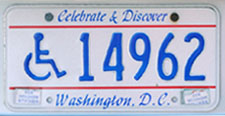 |
1991 Baseplate with slogan at top Although the Celebrate and Discover slogan debuted on auto plates in mid-1991, it was probably a few more years before all 1984 bases could be issued, at which time the change would have been reflected on HP plates. The lowest and highest numbers observed on plates of this style are 12493 and 15430. |
|
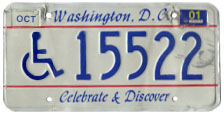 |
1991 Baseplate with slogan at bottom When the passenger plate numbering format was changed to AB-1234 in April 1997, the position of the city name and slogan were reversed, but when this change was reflected on HP plates is unknown. The lowest and highest observed numbers observed on this plates of this style are 15522 and 17425. | |
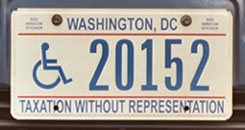 |
2000 Baseplate The earliest observed HP plates with the "TAXATION" legend are flat and feature the city name in the font introduced on auto plates in Oct. 2002, so we assume they were issued sometime after that month, presumably when the supply of 1991 baseplates was exhausted. The lowest observed number is 20000. | |
| Medical Doctor | First Issued: unknown |
|
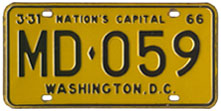
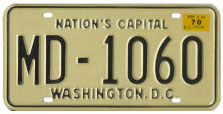
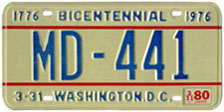
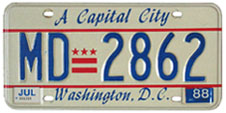
The first confirmed, distinctive MD registrations and plates are those issued for the 1964 registration year, which are comprised of the letters MD followed by three numbers. That 1964 MD-prefix plates are representative of a separate registration type, or at least a distinct series of registrations classified as "private passenger," is obvious because general-issue auto plates of this and later years were not numbered in the same configuration. The 1965 (exp. 3-31-66) plate pictured above, no. MD-059, is an example. Not only is this plate distinct from regular auto plates because the numbering configuration is different, it is also noteworthy because the three-digit serial is below 100 whereas when auto plates were numbered in the AB-123 format, numbers of each letter series began at 100. For example, from 1957 through 1963 passenger plate AB-100 would be issued, but AB-001 through AB-099 would not.
Questions arise, however, when we consider the 1957 ("3-31-58") through 1963 ("3-31-64") registration years. MD-prefix plates are known from this period, but whether for each year all or some were assigned deliberately to physicians is unknown.
|
We have found no documentation that indicates when MD-series numbers were first set aside for use exclusively by physicians, and we do not know if this occurred prior to the 1964 registration year. The AB-123 format was used on auto plates of seven years, 1957 through 1963, and for at least the first three, MD-series plates were not be deliberately assigned to physicians, but rather were issued sequentially, and randomly as to their assignees, in the normal course of business. This we know from two letters written by Commissioner Robert McLaughlin during 1959.
On the final day of March, Commr. McLaughlin responded to a suggestion made by Mr. Theodore Wiprud, executive director of the Medical Society of the District of Columbia, in which he asked the commissioners to consider assigning plates of the MD series to medical doctors. Commr. McLaughlin seemed open to the idea, responding “I shall be glad to discuss this with the other members of the Board of Commissioners. My only reservation, offhand, would be in making such issuance to a physician automatic.”
Separately, on August 10, 1959, a reporter from Peekskill, New York, wrote to Commr. Mclaughlin to inquire as to whether special plates were issued in D.C. to physicians, among others. “Here in New York State,” wrote Mr. Michael Blake, “special license plates are issued to physicians, registered nurses and newsmen. I plan a feature dealing with the various occupations that are given this special recognition. In New York the plates are the same as all others but the letter prefixes are different, such as Physician, MD; Registered Nurse, RN; and Newsman, NYP. An additional charge is made for each such registration.” Commr. McLaughlin responded "Please be advised that in the District of Columbia no special license plates are issued to members of any profession or occupation on the basis of their membership therein.”
To summarize, we know that MD-series plates were not set aside for use exclusively by physicians for the 1959 registration year but that the president of the Board of Commissioners was open to a suggestion received in March 1959 that such a practice be adopted; that within six months he was made aware that this was already being done in New York; and that distinctively-marked MD plates were issued in D.C. for the 1964 registration year. The question, then, is whether for 1960, 1961, 1962, or 1963 the MD series was reserved for use only by physicians, at their option. Quite simply, we don't know, and although we believe it is likely, we have no clues upon which to base a guess as to in which year the special significance of this letter series began. We have not yet encountered evidence about the use of MD-series registration numbers during this four-year period, so for the time being we consider 1964 to be the first year of issue for this type. DMV memos in which plates of each of these years are described and defined in conjunction with their being approved by the commissioners, an example of which is shown here, make no mention of the MD series. It is possible, however, that MD plates were already being reserved for doctors but that this fact was omitted from the annual plate proposal memos either inadvertently or simply because they were, in fact, regular automobile plates.
When MD-series plates ceased to be available is unknown, but the absence of examples made on the 1991 and 2000 baseplates suggests that they were not offered after mid-1991. Because plates of the 1984 and earlier bases continue to be seen in use, albeit rarely, it appears that a wholesale replacement of MD plates has not occurred since March 1974. Registration numbers observed on 1974, 1978, and 1984 baseplates are as follows:
Observed Registration Numbers
|
||
Lowest |
Highest |
|
| 1974 ("BICENTENNIAL") base | MD-126 |
MD-1372 |
1978 ("NATION'S CAPITAL") base |
none observed; use uncertain |
|
1984 ("A Capital City") base |
MD-2862 |
MD-3222 |
| Non-Resident | Earliest Known: 1920 |
|
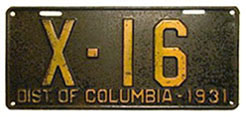
Specially-marked plates issued during the 1920s and at least into the early 1930s to individuals that were not D.C. residents but who remained in the District with their vehicle for longer than 15 days are marked with an X prefix. The 1931 plate shown is the latest known example of this type. Non-resident plates, some designated by an X-prefix, were issued in several states during this era before uniform reciprocity laws among the states and D.C. were enacted.
| Personalized Motorcycle | First Issued: unknown |
|
 |
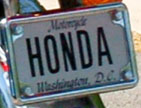 |
Privately-owned vehicle plates of types listed below are addressed on dedicated pages that may be reached by the links provided.
Antique Car |
||
| Diplomatic - DPL series | ||
| Elected Officials | ||
| Historic Motor Vehicle | ||
| Motorcycle | ||
| Personalized | ||
| Temporary and Special Use |
|
This page last updated on December 31, 2017 |
 |
|
copyright 2006-2018 Eastern Seaboard Press Information and images on this Web site may not be copied or reproduced in any manner without consent of the owner. For information, send an e-mail to admin@DCplates.net |














